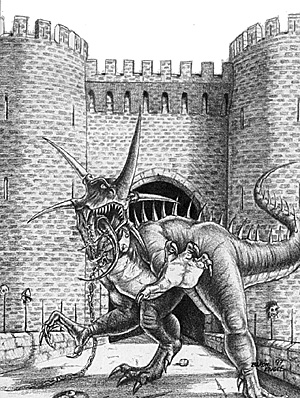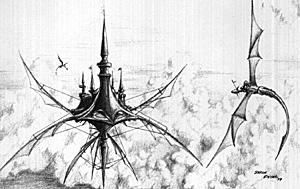 Castles! Mighty bastions of defense, where
characters or monsters abide, protected from attack?
Not when powerful magic exists.
Castles! Mighty bastions of defense, where
characters or monsters abide, protected from attack?
Not when powerful magic exists.
High powered player characters (PCs) in fantasy role-playing games often have an easy time knocking over castles. They use magic to sneak up the fortress without being detected, magic to get in (thus catching the defenders by surprise), and a barrage of more magic to eliminate most of the men-at-arms. Warriors in the party polish off any other defenders who manage to close with them. The castle hasn't provided any protection for the bulk of its inhabitants. Instead, it's become a death trap.
Ultimately, the battle for the castle hinges on a showdown between its most powerful leaders and the party. Although the leader might be tough, his followers can't match the overall abilities of a powerful party, plus the PCs generally have more and better magic items.
Even if the adventurers are temporarily repulsed, they can run away, get healed up, memorize some more spells and try again against the battered and demoralized garrison. Or, they can just call up some monsters to pulverize the place. Scratch another "fortress".
The same results might occur if a group of highlevel non-player characters raid a PC's castle when he's not there to protect it. So what's the point of building one?
In a magical universe, the use of spells almost completely negates the defensive potential of ordinary medieval-style castles. It's reasonable to assume that magical methods would be invented to counter such attacks. A castle is the biggest investment any character will make and it's well worth spending extra money to protect it. Two important considerations are detection of enemies and defense against magic.
Dectection of Enemies
The perception of invisible intruders can be accomplished in several ways. A mage could periodically cast detection type spells. Alternatively, magic items with a similar effect could be used, but they have the disadvantages of limited range and duration. Automatic, round-the-clock observation is better.
Permanent alarm spells can be used to detect invisible enemies. These spells can be spaced at appropriate distances around the castle walls to provide complete coverage.
Mists and fogs might enable someone to get a general idea of the location of invisible intruders. Dust on the floor will be disturbed by footprints. Flour could be thrown into suspect areas, temporarily revealing trespassers.
One of the simplest additions to defense is man's best friend. Dogs, using their keen sense of smell, easily detect invisible and silent intruders. They can accompany guards on patrols or be stationed in front of strategic doorways. Other possible watch animals include trained bears, lions, wolves, tigers, weasels, or giant-sized animals and monsters.
The detection of intruders on different, but adjoining, planes of existence is more difficult than discovering invisible ones. Enchanted stonework, lead plating, or magical screens and protective fields can keep them out. Some spells or magic items also warn of the presence of these beings. The most potent defense, probably limited to use by powerful wizards, is the creation or employment of conjured beings, familiars, or automatons, who can not only warn their masters of invaders but also attack them.
Anti-Flyer Defenses
Magic and the use of certain monsters allow characters to fly -- something not anticipated by medieval castle builders. With a few modifications, castles can be built to defend against flyers as well.
Today, we are used to seeing photos of castles that have suffered the effects of time. Usually they are in ruins or have been heavily modified; especially the roofs. Most medieval castles had very pointy roofs on their towers and keeps, sloped with angles of 45 to 75 degrees. If the roof was made of ceramic tile or had a layer of metal plating, it would be quite slippery, and provide only the most precarious landing place. Wall walks can have roofs over them, too.
Open areas, such as baileys and courtyards, can be protected by planting rows of tall spears which would impale any descending creatures. Nets to entangle flyers can strung between the spears.
Upper windows would either be arrow slits, too small for entry, or be heavily barred and shuttered.
Since outer fortification walls were routinely designed to provide flanking fire between towers, there is no reason that the interior parts of a castle couldn't be built in a similar way. Each building or tower would be covered by ballista and missile weapon fire from several other points. It would also be advantageous for the defenders to be able to move between the different parts of the castle without having to go outside; tunnels or covered walkways could connect various sections.
Don't forget that attackers are particularly vulnerable when they first touch the ground; that's when defenders can drop rocks or boiling oil on them. Flying creatures hit by ballista or catapult missiles should check to see if they are knocked out of control by the impact of the blow; there is no ground to fall on and absorb the shock.
MAGICAL DEFENSES
One possibility for defense is if certain fortitications were built by an "ancient race" and their stones resist the effect of any magical spell, either intrusive or destructive. An example is the Tower of Minas Tirith in J. R. R. Tolkien's Lord of the Rings trilogy. The walls of that city were totally unbreachable by Sauron's siege machines (however, a specially enchanted ram manned by trolls broke down the main gate). Possession of such a castle could be of great value to a ruler or villain.
Another option is allowing the walls of castles to be enchanted so they will become magically resistant, The resistance must be at least moderately strong or it wouldn't be worthwhile to have it. Any spell cast at the castle must overcome this magic resistance, or it Will fail completely. Creatures sheltering behind the walls gain the benefit of the magic resistance against damage.
One enchantment possible for structures would render them immune to the effects of normal weapons and fire. Only magical siege equipment will be able to damage such fortifications. Spell damage to the struc,ture or defenders would be half the normal amount.
More mundane methods can protect their castles from magic. Lead was a common building material in ancient and medieval times and might be used to shield rooms and towers from magical entry or scrying by telepathic means. It would be expensive, but possible, to protect an entire castle with lead linings.
It is also highly likely that locks and doors will be made of anti-magical materials to prevent spells from opening them. Other standard means of protection are the various trap and protection spells which can be placed in the interior of a castle. Magical devices are also valuable in this regard. The effectiveness of these protections might depend on maintaining an unbroken circuit of outer walls, having a consecrated altar, relic or holy item, keeping a sacred fire burning, etc.
An anti-magic room is a location where magic items temporarily lose all their magical properties, and spells that are cast automatically fail. These rooms make good prisons for sorcerers. Attacking parties heavily dependent on magic could be lured into an anti-magic room, locked in, and forced into hand-to hand combat with creatures that deal out a lot of damage. PCs used to relying on magic will find some ogres in heavy plate armor with two-handed swords a tough proposition.
One of the best magical defenses is a permanent, large scale anti-magic screen or globe that protects the entire castle, above and below. Any persons who tried to go through it by sorcerous means would find their enchantments dissipated. Multiple spells could be used on a fortification to protect each part, such as inner wall and keeps.
Fortresses protected by a such as screen will have protection from magic commensurate with their mundane stone defenses. All but the most powerful spells could not be cast into the castle, but the defenders can throw spells outwards. This doesn't mean magic can't be used at all (it can be used once you're inside), but it makes it much more difficult to get in -- which is as it should be.
Not every castle will have all the different magical defenses mentioned above. A castle without magical defenses might be somewhat obsolete, while a stronghold with complete defenses against spells, intruders, and flying creatures would be considered "state-of-the-art", or the ultimate fortress.
SPECIAL MAGIC CASTLES
Some castles have special properties. For example, castles need not be made stone. There are legends of castles made of ice, crystal, glass, fire, iron, bones, and clouds. The following table can be used for inspiration for unique fortresses:
1. Invisible
The best defense is not to be seen. The party may accidently "bump" this fortification. The gamemaster must determine how the invisibility affects the PCs if they go inside (will they be able to see the castle, what's inside it, or each other?)
2. Illusory
This phantom castle has two aspects. It can be an illusion that does not really exist at all, or appears to be something else; a small cottage, perhaps.
 3. Flying/Floating
3. Flying/Floating
A aerial stronghold. It may be found on a cloud or an inaccessible mountaintop. Typical inhabitants are cloud-living giants and flying creatures.
Flying castles may have a magical device which sets course, speed and altitude.
4.Sunken
This castle is underwater. The denizens are aquatic monsters rather than those usually encountered. To make things easier, the GM may rule that on certain days for a limited period of time a general "water-breathing" type spell is in effect on the castle for PCs who descend to explore.
5. Teleporting/Gate
This castle has the ability to teleport from place to place or between dimensions. The destination and time spent in each place is random, although some teleporting castles return to a specific spot on a particular date. It may alternatively be a gateway to another dimension that opens at a certain time (like midnight on Halloween).
6. The Magnetic Castle
A castle found on an island which attracts passing ships (due to the metal in them). It also attracts the iron in PCs possessions. The only way to leave is to discard all ferrous metal items.
 7. Haunted/Cursed Castle
7. Haunted/Cursed Castle
This place is under a much more powerful enchantment than your run-of-the-mill curse. The GM needs to devise a story of how the curse came about. The party may not be able to leave without discovering the "key" to the curse and dispelling it, or at least having to make some sacrifice (magic items are good ones). The monster inhabitants are under the curse, too and cannot be permanently destroyed until it's broken (they are automatically brought back to life). GMs might want to throw in some special monster, which is the embodiment of the curse, like Jason or Freddie Krueger, to liven things up.
8. The Sacred Castle
This place has a holy shrine, temple, well, relic , or artifact that can bestow favors and is the object of quests. Evidence of the relic's existence is usually hidden. However, all who enter must pass some type of test as to their worthiness. The GM must tailor the test to the party, but it should be designed to weed out those of greedy or violent temperament. Those who fail may never return; particularly irreverent PCs are blasted to ashes. If the party becomes obnoxious, the castle and its inhabitants will disappear.
9. Trapped
Trapped castles are dangerous places. Typical traps and monsters include animated swords or furnishings, mechanical warriors, invisible monsters, barriers of whirling knives, hidden auto matic- firing/reloading crossbows, fully armored giants, spying magic eyes in the rooms and towers (monsters are never surprised, but PCs are usually are), creatures immune to iron weapons, raging lions (double normal strength), mistfilled chambers, etc.
10. Enchantress
An enchantress' castle is surrounded by a girdle of fear and confusion. This causes all who come within two miles to be affected by a powerful fear spell. Those who fail to resist must leave the area for one full day. Those who suceed may enter the girdle, but must then defeat an enchantment that makes them lose their way. Lost characters will always wander away from the castle. Dispelling the girdle's magic will only temporarily alleviate these affects.
Any stressful situation (including combat) inside the girdle will require the PCs to resist becoming confused. Confusion causes PCs to misidentify targets, stand in stupefaction, wander away, etc. The enchantress has various potions and magic items that will cause intruders to lose their memory. She may also use illusions and her own feminine wiles to manipulate interlopers. Charmed guards will always be present. She will try to trap wizard PCs in a tower of air which is an effective prison; it's a sphere composed of an impenetrable forcefield, and is anti- magical inside. The castle may also be under a curse which prevents a character who has been unfaithful in any way from leaving on his own.
11. Faery Castle
Faery castles are full of magic and whimsy. For example, Oberon's Castle of Gold, hidden deep in an enchanted forest, has a goblet that produces endless amounts of wine, a wand that casts mass sleep spells, and a dancing horn that causes listeners to dance for hours when sounded.
12. Castle of Abundance
This place of healing and repose is adorned with bubbling fountains and luxurious furnishings. Invisible servitors tend to the needs of visitors, including serving sumptuous feasts. Natural healing takes place at twice the normal rate. Injured characters will be offered a potion of healing upon their arrival. All fatigue and hunger will be gone after a full day of rest and dining.
Back to Shadis #39 Table of Contents
Back to Shadis List of Issues
Back to MagWeb Master List of Magazines
© Copyright 1997 by Alderac Entertainment Group
This article appears in MagWeb.com (Magazine Web) on the Internet World Wide Web.
Other military history articles and gaming articles are available at http://www.magweb.com